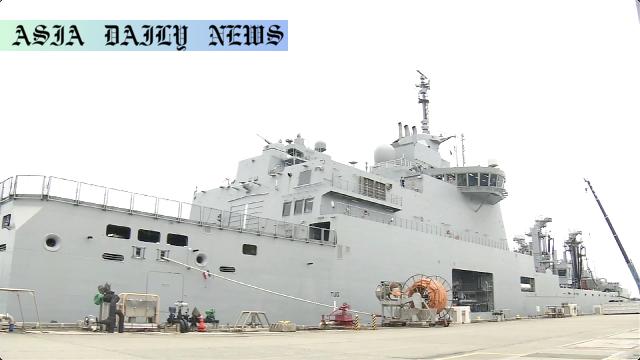French Navy steps up its presence in Indo-Pacific region with key strategic drills and North Korea monitoring activities.
French Navy frigate makes a port call at a US base in Okinawa and joins naval exercises with Japan and the US.
The exercises—the first since 1968—aim to strengthen capabilities and monitor UN resolution violations by North Korea.
Demonstrates advanced military technology and symbolizes growing cooperation in Indo-Pacific amidst China’s maritime rise.

Introduction
The French Navy has embarked on a historic mission in the Indo-Pacific region, making a significant port call at a United States military base in Okinawa, Japan. This mission marks the return of a French carrier strike group to the Pacific for the first time since 1968. The effort not only solidifies trilateral cooperation with Japan and the United States but also reflects France’s strategic interest in this geopolitically vital region.
Port Call in Okinawa: A Strategic Move
On Thursday, a French Navy frigate, accompanied by a supply ship, docked at the White Beach Naval Facility in Uruma City, Okinawa. These vessels are components of a French aircraft carrier strike group actively participating in the Pacific Steller exercise. The drills, focusing on enhancing mutual operational capabilities, involve high-profile activities such as fighter jets landing on aircraft carriers, at-sea refueling of Japanese Maritime Self-Defense Force ships, and coordinated strategic operation simulations.
Advanced Military Technology: A Showcase
During the port call, reporters were given a rare opportunity to explore the frigate’s state-of-the-art weaponry. Displays included missiles capable of intercepting ballistic projectiles—specifically those deployed against Houthi rebel activities in Yemen—and a 76-millimeter gun for drone neutralization. These technologies emphasize the French Navy’s preparedness for advanced maritime defense scenarios.
North Korea Monitoring and Regional Stability
Additionally, the French Navy operation seeks to monitor North Korea’s maritime activities, particularly in enforcing UN Security Council resolutions. This includes surveillance efforts against illegal transport of refined petroleum products. Such initiatives are vital for maintaining regional stability and compliance with international regulations.
A China-Focused Indo-Pacific Agenda
With China’s increasing maritime assertiveness, the French military’s amplified presence in the Indo-Pacific underscores its proactive stance. The deployment of a full strike group in the region showcases France’s commitment to safeguarding free and open navigation, an issue central to the global maritime order.
Historical Context and Diplomatic Significance
This deployment is the first time a French strike group has entered the Pacific since 1968. The symbolic nature of this move bridges decades of dormant French activity in the region and signals a renewed commitment to fostering international partnerships. It also reiterates France’s broader maritime strategy of ensuring a free and open Indo-Pacific while building operational synergy with allied forces.
Conclusion
This historic operation by the French Navy highlights the evolving dynamics of defense partnerships in the Indo-Pacific. The region, marked by complex geopolitics and growing tensions, benefits from such multi-national cooperation aimed at promoting security, stability, and freedom of navigation. As France deepens its involvement, its commitment to a rules-based international maritime order remains evident, serving as a beacon for other nations to join hands in mutual defense and peace efforts.
Commentary
Reaffirming Strategic Alliances
The French Navy’s latest mission in the Indo-Pacific is a powerful demonstration of strategic alliances at work. The trilateral exercises with the United States and Japan represent a determined step toward reinforcing operational interoperability and defense readiness. Such collaborations are essential in today’s fraught geopolitical landscape, especially as nations seek alignment over shared challenges like regional instability and maritime security.
Significance of Enhanced Presence
The move to deploy a full strike group for the first time since 1968 is not just a symbolic return—it reflects a tangible commitment to the Indo-Pacific. With France joining hands to enforce UN Security Council resolutions and counter illegal activities, including North Korea’s smuggling operations, the operation sends a strong message about global compliance and collective responsibility. By extending its reach, France aligns itself with the broader goals of maintaining peace and security throughout the region.
Looking Toward the Future
France’s Indo-Pacific agenda is clearly designed to counteract growing maritime challenges posed by an increasingly assertive China. The French military’s technological capabilities, as evidenced by the advanced weaponry on display, make it a formidable partner in addressing these challenges. As the French Navy solidifies its presence, it also sets an example of how collaboration and preparedness can serve as robust deterrents to potential conflicts.
Conclusion
This mission not only symbolizes a historic moment for the French Navy but also reiterates the importance of unity among allies in navigating complex global issues. It serves as a reminder that no nation can single-handedly tackle the challenges of regional security, and partnerships will always remain the cornerstone of peace and progress.


